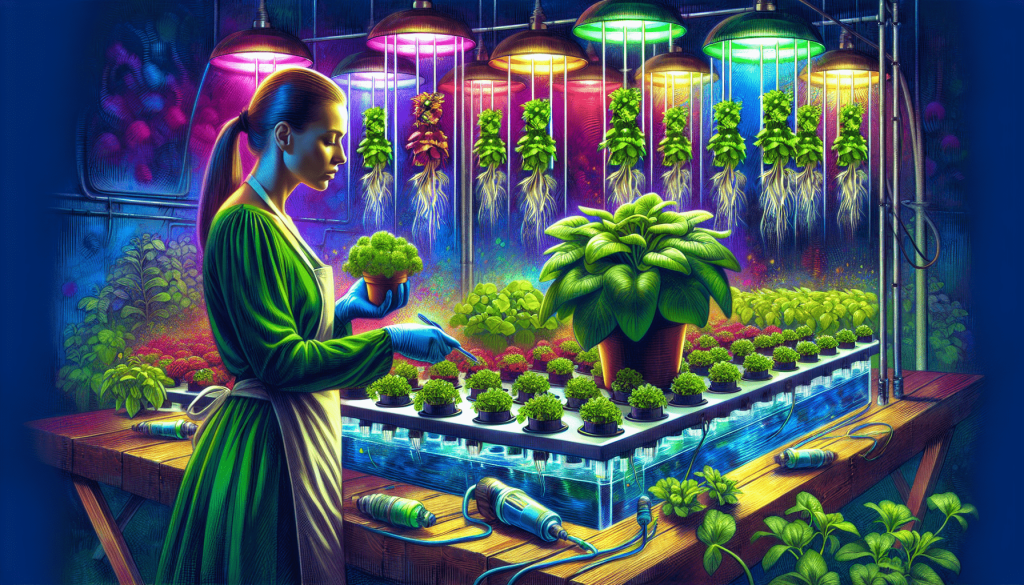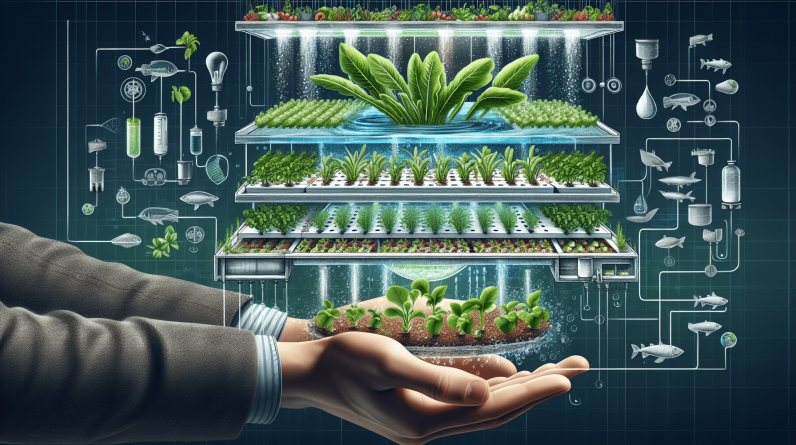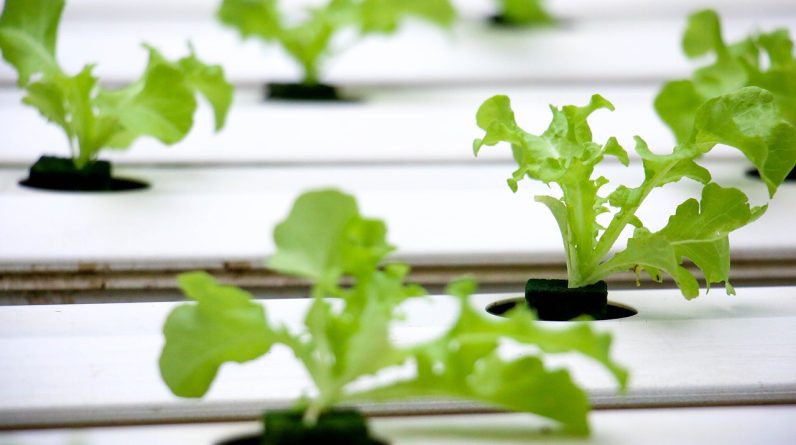
Are you tired of waiting for the perfect weather conditions to grow your favorite plants? Look no further than hydroponic gardening! With this innovative technique, you can cultivate a wide variety of plants, from herbs to leafy greens, without the need for soil. By providing plants with the perfect balance of water, nutrients, and light, hydroponic gardening offers the opportunity to increase your yield and maximize growth potential. Say goodbye to the limitations of traditional gardening methods and embrace the future of sustainable cultivation.

Choosing the right plants
Consider plant size and root structure
When choosing plants for your hydroponic garden, it’s important to consider their size and root structure. Some plants, such as lettuce or herbs, have shallow root systems and can thrive in smaller containers. On the other hand, plants like tomatoes or cucumbers have deep root systems and require larger containers. By selecting plants that are compatible with the size of your hydroponic system, you can ensure they have enough space to grow and develop properly.
Select plants with higher yield potential
To maximize your yield in hydroponic gardening, it’s essential to choose plants with higher yield potential. Look for varieties that are known for their productivity and abundant harvests. For example, certain types of cherry tomatoes or peppers are known to produce a high number of fruits. By selecting plants with a reputation for high yields, you can increase your chances of a successful and productive hydroponic garden.
Choose disease-resistant varieties
Another important factor to consider when selecting plants for hydroponic gardening is their resistance to diseases. Some plant varieties have been bred to be more resistant to common diseases that can affect hydroponic systems, such as root rot or powdery mildew. By choosing disease-resistant varieties, you can reduce the risk of plant loss and ensure a healthier overall garden. Look for plant labels or seed descriptions that indicate disease resistance to make informed choices.
Optimal nutrient solution
Maintain the correct nutrient balance
In hydroponic gardening, providing the correct balance of nutrients is crucial for healthy plant growth. The nutrient solution serves as the plant’s primary source of essential elements, so it’s important to regularly monitor and adjust the nutrient levels. A balanced nutrient solution should contain all the necessary macro and micronutrients, such as nitrogen, phosphorus, potassium, calcium, magnesium, and iron. By maintaining the correct nutrient balance, you can support vigorous plant growth and maximize your yield.
Monitor pH levels regularly
Another aspect of optimal nutrient solution management is monitoring pH levels regularly. pH refers to the acidity or alkalinity of the nutrient solution and plays a significant role in nutrient availability to plants. Most plants thrive in a slightly acidic pH range of 5.5 to 6.5. Monitoring pH levels ensures that the nutrient solution remains within this range, allowing for optimal nutrient uptake. pH test kits or meters are readily available and can help you maintain the ideal pH levels for your hydroponic garden.
Adjust nutrient solution according to plant growth stages
Different plant growth stages require different nutrient ratios. As plants progress from seedling to vegetative growth and finally to flowering or fruiting, their nutrient requirements change. It’s important to adjust the nutrient solution composition accordingly to meet these changing needs. For example, plants in the vegetative stage require more nitrogen for leaf development, while flowering plants benefit from higher phosphorus levels to promote flower and fruit production. By adjusting the nutrient solution based on plant growth stages, you can provide the optimal nutrition at each phase of their development.
Proper lighting
Choose the correct type of lighting for your plants
Light is a vital factor in hydroponic gardening as it serves as a substitute for natural sunlight. The type of lighting you choose can greatly impact the growth and development of your plants. Depending on the plant species and growth stage, there are various lighting options to consider. LED grow lights are energy-efficient and can provide a full spectrum of light required for plant growth. High-intensity discharge (HID) lights, such as metal halide or high-pressure sodium, are commonly used for larger plants or those in the flowering stage. Research the lighting needs of your chosen plants and select the appropriate type to ensure optimal growth.
Provide sufficient light intensity and duration
In addition to selecting the correct type of lighting, it’s essential to provide sufficient light intensity and duration for your plants. Light intensity refers to the brightness of the lighting source and is measured in foot-candles or lux. Different plants have different light intensity requirements, with leafy greens generally needing lower levels compared to fruiting plants. Duration, on the other hand, refers to the number of hours of light exposure each day. Most plants require 12-16 hours of light during the vegetative stage and 8-12 hours during the flowering stage. Providing adequate light intensity and duration ensures that your plants receive the necessary energy for photosynthesis and optimal growth.
Use timers to regulate lighting
Consistency in light exposure is crucial for the healthy growth of plants in a hydroponic system. Using timers to regulate lighting allows you to maintain a consistent schedule and ensure your plants receive the required amount of light each day. Timers can be set to turn the lights on and off at specific times, mimicking natural light cycles and promoting regular growth patterns. By using timers, you can eliminate the risk of forgetting to turn the lights on or off and establish a routine that benefits your plants.
Effective water management
Use a reliable water source
Water is a vital component of hydroponic gardening, as it serves as the medium through which nutrients are delivered to the plants’ root systems. It’s important to use a reliable water source that is free from contaminants and impurities. Ideally, you should use filtered or distilled water to prevent the buildup of harmful substances or minerals that can interfere with nutrient absorption. If using tap water, it’s recommended to let it sit for 24 hours to allow chlorine to evaporate before using it in your hydroponic system.
Monitor and maintain proper water temperature
Water temperature plays a significant role in the success of a hydroponic garden. Most plants thrive in water between 65°F to 75°F (18°C to 24°C). Temperature fluctuations outside this range can stress plants and negatively impact growth. It’s important to monitor and maintain the proper water temperature by using water heaters or coolers as necessary. By providing the correct water temperature, you can create an optimal environment for your plants to absorb nutrients and thrive.
Implement a recirculating system for water conservation
Water conservation is an important consideration in hydroponic gardening, especially as water scarcity becomes a growing concern. By implementing a recirculating system, you can minimize water waste and promote sustainable practices. A recirculating system collects and treats the runoff water, which is then reused in the hydroponic system. This can significantly reduce water consumption while maintaining a consistent nutrient solution for your plants. By implementing water conservation measures, you can minimize your environmental impact and contribute to a more sustainable future.
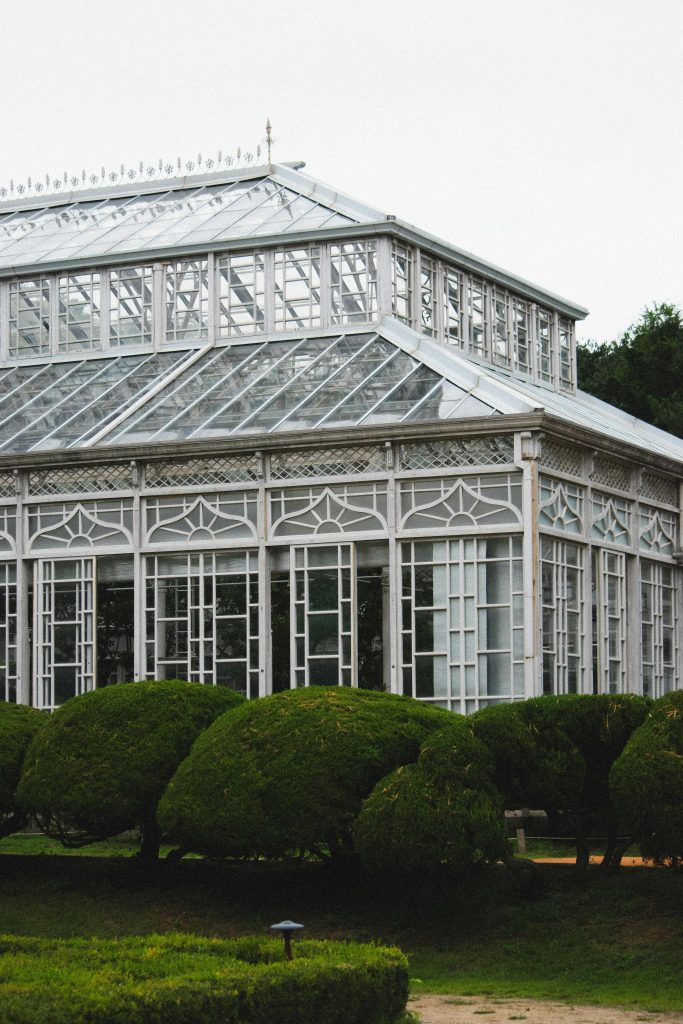
Temperature and humidity control
Maintain optimal temperature range for plant growth
Temperature control is crucial in hydroponic gardening to provide an environment that promotes healthy plant growth. Different plant species have varying temperature preferences, but most thrive within a temperature range of 65°F to 75°F (18°C to 24°C). It’s important to monitor and maintain the temperature within this range to optimize growth and avoid stress. Using a thermometer and adjusting the ambient temperature or using heating/cooling devices can help you maintain the ideal temperature for your hydroponic garden.
Use ventilation and fans to regulate humidity levels
Humidity levels also play a vital role in the success of a hydroponic garden. Plants require a certain level of humidity in the air to prevent dehydration and ensure proper transpiration. However, high humidity can lead to excessive moisture and create a favorable environment for mold and mildew growth. To regulate humidity levels, it’s important to use ventilation systems and fans to promote air circulation and prevent the buildup of excess moisture. This can help maintain the ideal humidity range, typically between 40% and 60%, depending on the plant species.
Avoid extreme temperature fluctuations
Extreme temperature fluctuations can cause stress to plants and negatively affect their growth. Rapid changes in temperature can disrupt physiological processes and lead to leaf wilting, root damage, or decreased overall health. It’s important to avoid such fluctuations by providing a stable environment for your hydroponic garden. Insulating your hydroponic system, using heating or cooling devices, and monitoring temperature changes can help you maintain a stable and consistent temperature range. By avoiding extreme temperature fluctuations, you can ensure the optimal health and productivity of your plants.
Appropriate growing media
Select a suitable growing medium for your plants
Choosing the right growing medium is essential for plant development in a hydroponic system. The growing medium serves as a support structure for the plants’ root systems, facilitating nutrient and water absorption. There are various types of growing media available, including rockwool, perlite, coconut coir, and clay pellets. Each medium has its own advantages and considerations, such as water retention capacity, pH neutrality, and aeration properties. Research the needs of your chosen plants and select a suitable growing medium that promotes healthy root growth and provides proper support.
Ensure good drainage and aeration
In addition to selecting a suitable growing medium, ensuring good drainage and aeration is crucial for a successful hydroponic garden. Poor drainage can result in waterlogged roots and oxygen deprivation, leading to root rot or fungal diseases. Adequate aeration is also necessary to supply roots with oxygen, as they require oxygen for respiration. Proper drainage can be achieved by using containers with drainage holes or using a substrate that allows excess water to flow freely. Aeration can be improved by incorporating materials like perlite or vermiculite into the growing medium. By ensuring good drainage and aeration, you can promote healthy root development and prevent root-related diseases.
Monitor and adjust media pH levels
The pH level of the growing media can impact nutrient availability to plants. It’s important to monitor and adjust the pH of the media to ensure optimal nutrient absorption. Most plants thrive in a slightly acidic to neutral pH range, typically between 5.5 and 6.5. Regularly testing the pH of the growing media and making adjustments using pH-up or pH-down solutions can help you maintain the ideal pH range. By monitoring and adjusting media pH levels, you can optimize nutrient availability and support healthy plant growth.
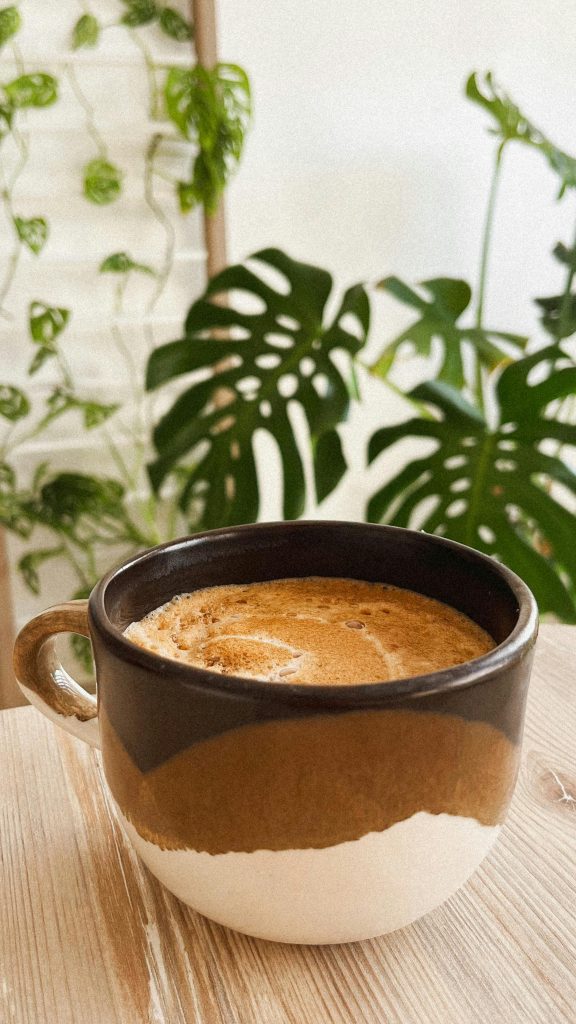
Regular monitoring and maintenance
Check plants for signs of pests or diseases
Regular monitoring of your hydroponic garden is essential to catch signs of pests or diseases early and prevent their spread. Inspect your plants regularly for any abnormalities such as yellowing leaves, spots, or unusual growth patterns. Look for signs of pests like aphids, spider mites, or whiteflies. By promptly identifying and addressing pest or disease issues, you can minimize damage to your plants and prevent further infestation. Regular monitoring allows you to take proactive measures and maintain a healthy, pest-free hydroponic garden.
Regularly clean and sanitize hydroponic system components
Maintaining cleanliness and hygiene in your hydroponic system is crucial for its overall health and efficiency. Regularly cleaning and sanitizing system components help prevent the buildup of algae, bacteria, or fungi that can impede nutrient uptake or pose a risk to plant health. It’s important to clean and sterilize equipment such as reservoirs, pumps, and tubing regularly. Use a mild detergent or hydrogen peroxide solution to clean surfaces, and rinse thoroughly to remove any residue. By incorporating regular cleaning practices, you can promote a clean and sanitized environment for your plants to thrive.
Prune and train plants for maximum yield
Pruning and training plants is an important technique to optimize yield in hydroponic gardening. Certain plants benefit from pruning to remove excessive growth, improve airflow, and enhance light penetration to lower leaves. Training involves manipulating the plant’s growth pattern to maximize space utilization and improve overall productivity. Techniques such as topping, trellising, or using plant clips can guide the growth of your plants and encourage the development of multiple flowering sites. By practicing proper pruning and training techniques, you can shape your plants for maximum yield potential.
Pollination techniques
Learn about self-pollinating and cross-pollinating plants
Understanding the pollination requirements of your chosen plants is essential for achieving successful fruit or seed production. Some plants are self-pollinating, meaning they can produce fruits without external assistance. Others require cross-pollination, where the transfer of pollen from one flower to another is necessary for fertilization. By learning about the pollination requirements of your plants, you can determine if manual intervention or the introduction of pollinators is necessary.
Utilize manual pollination methods
For plants that require cross-pollination or for gardeners who want to increase their yield, manual pollination methods can be employed. This involves transferring pollen from the male flower to the female flower using a small brush or cotton swab. By manually pollinating your plants, you can ensure proper fertilization and the development of fruits or seeds. It’s important to research the specific pollination techniques for your chosen plants to achieve the best results.
Introduce beneficial insects for natural pollination
Another option for pollination in a hydroponic garden is the introduction of beneficial insects. Insects such as bees, butterflies, or bumblebees are natural pollinators and can facilitate cross-pollination in your garden. By providing a welcoming environment for these beneficial insects, such as flowering plants or shelter, you can attract them to your hydroponic garden and enhance pollination rates. Research local beneficial insect species and implement strategies to attract and support their presence in your garden.
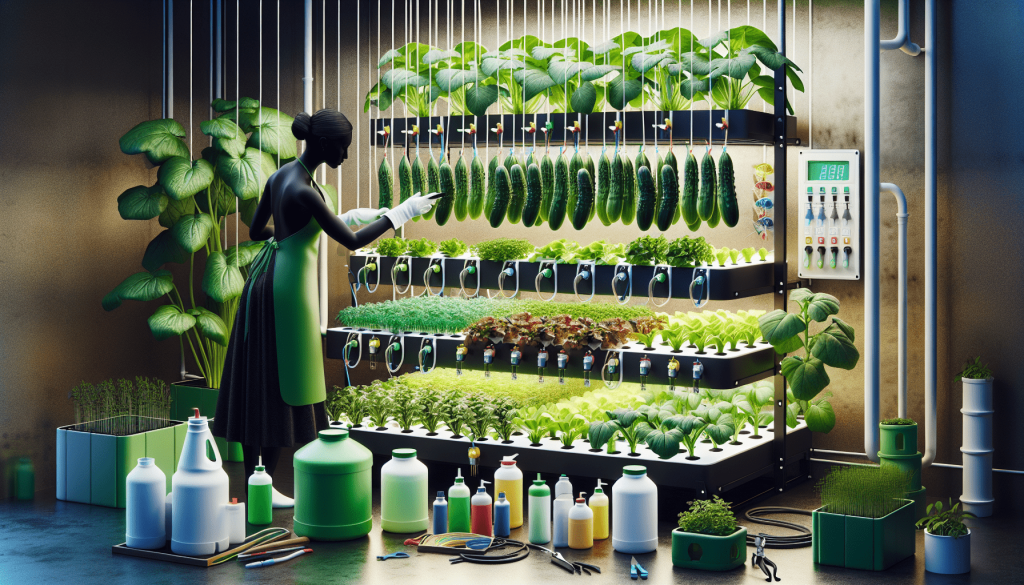
Proper plant spacing
Provide adequate space for plant growth
Proper plant spacing is essential to ensure adequate airflow and light penetration in your hydroponic garden. Overcrowding can lead to competition for resources, increased humidity levels, and decreased overall plant health. Providing adequate space between plants allows for proper air circulation, reducing the risk of fungal diseases. It also allows individual plants to receive sufficient light, promoting uniform growth and preventing shading. Research the recommended spacing requirements for your chosen plants and adjust accordingly to optimize plant health and productivity.
Avoid overcrowding to prevent competition for resources
Overcrowding plants in a hydroponic system can lead to competition for resources such as nutrients, water, and light. This can result in stunted growth, reduced yields, and an increased risk of disease or pest infestation. It’s important to avoid overcrowding by maintaining proper spacing between plants. This allows each plant to have access to the necessary resources for its growth and development. By preventing overcrowding, you can create a healthier and more productive hydroponic garden.
Utilize trellising and support systems
In some cases, plants benefit from additional support systems such as trellises or stakes. These structures help optimize space utilization and provide support for plants with trailing or vining growth habits. By training plants to grow vertically and utilizing trellising or support systems, you can save space and maximize the potential yield of your hydroponic garden. Additionally, trellis systems can improve air circulation and light penetration, reducing the risk of diseases and promoting overall plant health.
Regular nutrient solution monitoring
Monitor nutrient solution conductivity and nutrient levels
Regular monitoring of the nutrient solution is crucial to ensure optimal nutrient availability for your plants. Conductivity (EC) meters can measure the electrical conductivity of the solution, giving an indication of the nutrient content. Nutrient levels should be within the recommended range for each plant species to avoid deficiencies or toxicities. Monitoring EC levels allows you to make necessary adjustments to maintain the desired nutrient concentration for your hydroponic garden.
Adjust nutrient solution strength as needed
As plants grow and progress through different stages, their nutrient requirements change. It’s important to adjust the strength of the nutrient solution accordingly. During the vegetative stage, plants may require a higher nutrient concentration to support rapid growth. Conversely, during the flowering or fruiting stage, adjusting the nutrient solution to a lower concentration can promote better flower and fruit development. Regularly testing and adjusting the strength of the nutrient solution ensures that your plants receive the optimal nutrition for each growth stage.
Prevent nutrient deficiencies or toxicities
Regular nutrient solution monitoring and adjustment help prevent nutrient deficiencies or toxicities in your hydroponic garden. Nutrient deficiencies can manifest as yellow or discolored leaves, stunted growth, or poor overall health. On the other hand, nutrient toxicities can cause leaf burn, wilting, or even death of the plant. By monitoring and adjusting nutrient levels, you can prevent these issues and maintain a balanced nutrient solution that supports healthy plant growth. Regular monitoring is key to identifying and addressing nutrient imbalances before they negatively impact your plants.
By following these guidelines for choosing the right plants, maintaining optimal nutrient solutions, providing proper lighting, managing water effectively, controlling temperature and humidity, using appropriate growing media, regular monitoring and maintenance, employing pollination techniques, ensuring proper plant spacing, and regularly monitoring the nutrient solution, you can increase your yield in hydroponic gardening. With attention to detail and a proactive approach, you can create a thriving hydroponic garden and experience the joy of bountiful harvests. Happy gardening!
